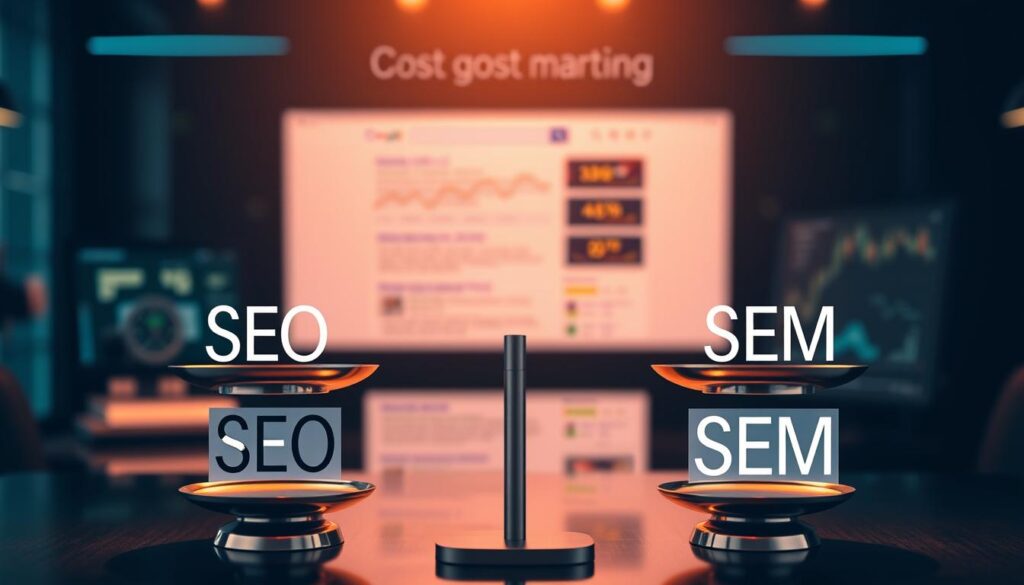When browsing search engines like Google, you’ve likely noticed two types of results: unpaid listings and sponsored ads. This split reflects two distinct strategies—search engine optimization (SEO) and search engine marketing (SEM). Though often confused, they serve unique roles in digital visibility.
SEO focuses on improving a site’s ranking through organic methods. Think of optimizing content, fixing technical issues, or earning backlinks. These efforts aim to attract your target audience naturally over time. Results may take months but often deliver lasting value.
SEM, however, combines SEO with paid tactics like pay-per-click (PPC) ads. This approach offers immediate visibility at the top of search pages. While SEO builds long-term authority, paid campaigns drive quick traffic. Platforms like Google clearly label paid ads, separating them from organic results.
Understanding this difference helps businesses allocate resources wisely. Whether prioritizing cost efficiency or rapid clicks, both strategies play vital roles. Let’s break down how each works—and why they’re stronger together.
Key Takeaways
- SEO targets organic rankings through content and technical improvements.
- SEM includes paid advertising (like PPC) alongside SEO efforts.
- Search engines display paid ads separately from organic listings.
- Organic strategies require time but offer sustainable growth.
- Paid campaigns deliver faster traffic but need ongoing budgets.
Understanding SEO Fundamentals
Climbing search rankings requires a solid SEO foundation. It combines technical precision with creative strategies to help websites earn visibility without paid ads. Three core elements drive success here.
Key Components of Search Engine Optimization
SEO relies on four pillars: on-page optimization, technical adjustments, off-page strategies, and user engagement. Each plays a unique role in signaling relevance to search engines. For instance, placing target keywords in title tags helps crawlers understand page topics.
| Component | Focus Areas | Examples |
|---|---|---|
| On-Page SEO | Title tags, content | Blog posts with keywords |
| Technical SEO | Site speed, mobile-friendliness | Compressed images |
| Off-Page SEO | Backlinks, social signals | Guest posts |
Effective keyword research ensures content aligns with what audiences search for. A cooking blog might target “quick dinner recipes” in headers and meta descriptions. Fast-loading pages and trustworthy backlinks also boost rankings.
The Role of Organic Search Traffic
Organic search delivers 53% of website visits globally. Unlike paid ads, these visitors often stay longer and explore more pages. Google prioritizes sites offering clear value through helpful content and smooth navigation.
Building authority takes time but pays off. For example, a local bakery could gain traction by optimizing for “gluten-free cupcakes” while earning reviews from food bloggers. Trust signals like expertise and author credentials strengthen this process.
Exploring the World of SEM
Businesses aiming for rapid visibility often turn to search engine marketing. This approach blends paid tactics with organic growth methods, creating a flexible path to reach audiences. Let’s unpack how paid campaigns operate and why combining them with organic efforts yields stronger results.

PPC and Paid Advertising Explained
Pay-per-click campaigns let businesses bid for ad placements at the top of search results. Advertisers set budgets and choose keywords, paying only when users click. Google’s Quality Score—based on ad relevance and landing page quality—determines placement and cost efficiency.
| Factor | Role | Impact |
|---|---|---|
| Bid Amount | Maximum cost per click | Higher bids increase ad visibility |
| Quality Score | Ad relevance + user experience | Improves rankings, lowers costs |
| Ad Copy | Message clarity | Boosts click-through rates |
For example, a travel agency might target “last-minute beach vacations” with urgency-driven headlines. Well-optimized ads can appear within hours, driving traffic while long-term SEO efforts mature.
Integrating Organic and Paid Strategies
Pairing paid campaigns with organic optimization creates a visibility loop. Data from PPC tests (like high-performing keywords) can inform content creation. Meanwhile, strong organic rankings reduce reliance on paid budgets over time.
A software company might use paid ads to promote a new feature while publishing detailed guides on the same topic. This dual approach captures both quick clicks and builds lasting authority. Aligning messaging across channels strengthens brand recognition and audience trust.
Examining How “are seo and sem the same” Impacts Your Strategy
Digital visibility hinges on choosing tactics that align with your goals. Organic growth and paid campaigns serve distinct purposes, each influencing how audiences find your website. Let’s explore their practical differences to help shape your approach.
Direct Comparison of Features
Organic strategies focus on gradual improvements, while paid methods prioritize speed. For example, optimizing page content for search engines takes weeks to show results. Paid ads, however, can position your business at the top of search results overnight.
| Feature | SEO | SEM |
|---|---|---|
| Primary Focus | Sustainable website authority | Immediate clicks |
| Cost Structure | Time investment | Daily budgets |
| Traffic Timeline | 3-12 months | 24-48 hours |
| Platform Example | Blog posts | Google Ads |
Timing and Results: Long-Term vs. Quick Wins
Building trust through organic methods creates lasting value. A well-optimized page might rank for years, attracting free traffic. Paid campaigns deliver instant visibility but stop working once funding ends.
Consider a local bakery: publishing recipe guides drives passive traffic over time. Running targeted ads for “birthday cakes near me” fills orders quickly. Combining both approaches balances immediate needs with future growth.
Smart businesses use paid data to refine organic content. High-performing keywords from Google Ads can guide blog topics. This synergy maximizes digital marketing budgets while building enduring search engine authority.
Cost Considerations in SEO and SEM
Budgeting for online visibility? Organic and paid strategies have contrasting financial footprints. While both aim to boost traffic, their cost structures demand different planning approaches. Let’s explore how to allocate funds wisely.

Upfront Investments and Ongoing Expenses
Organic growth often surprises businesses with initial costs. Quality content creation, technical audits, and link-building campaigns require upfront investments. A small business might spend $2,000-$5,000 monthly on tools, writers, and outreach.
Paid advertising operates differently. Google Ads campaigns start quickly but need continuous funding. For example, a $10 daily budget for “luxury watches” could cost $300 monthly—with traffic stopping once payments pause.
| Cost Factor | Organic | Paid |
|---|---|---|
| Initial Setup | $1,500+ | $100-$500 |
| Monthly Average | $800-$3,000 | $300-$5,000 |
| Traffic Duration | Years | Active campaigns only |
Budgeting for Sustainable Traffic
Long-term marketers often shift funds toward organic efforts over time. A blog post ranking for “best running shoes” can generate free clicks for years. Paid ads excel for product launches or seasonal promotions needing instant visibility.
One fitness brand reduced ad spend by 40% after six months of content optimization. They redirected savings into video tutorials, which now drive 25% of their site visits. Monitoring metrics like cost-per-click and organic session duration helps balance both strategies.
Key tips for budget harmony:
- Allocate 60% of initial funds to foundational SEO work
- Use paid campaigns to test high-value keywords
- Gradually reduce ad spend as organic rankings improve
Choosing the Right Mix for Your Business Goals
How do you balance long-term growth with immediate traffic? The answer lies in matching tactics to your unique priorities. Let’s explore how to blend methods for maximum impact.

Tailoring Tactics to Your Timeline
Start by asking two questions: When do you need results? and What can you invest? New businesses often focus on quick wins to build momentum. Established brands might prioritize lasting authority.
| Scenario | Recommended Approach | Example |
|---|---|---|
| Launching a product | 70% paid ads, 30% content | Promote via Google Ads while creating blog tutorials |
| Seasonal promotions | 50/50 split | Run holiday PPC campaigns alongside evergreen gift guides |
| Building brand trust | 90% organic, 10% testing | Publish case studies while monitoring ad keywords |
A fitness app startup used this framework effectively. They allocated 80% of their budget to targeted ads for instant user acquisition. Simultaneously, they developed video guides ranking for “home workout routines.” Within six months, organic traffic covered 40% of their visits.
Regular testing sharpens your strategy. Track metrics like cost-per-conversion for paid efforts and organic click-through rates for content. Adjust allocations quarterly based on performance data.
Remember: Flexibility wins. One e-commerce brand shifted from 60% paid to 70% organic after ranking for “sustainable activewear.” Their blended approach cut customer acquisition costs by 55% year-over-year.
Conclusion
Navigating digital marketing requires understanding two powerful tools. Organic growth builds lasting authority through content quality and technical precision. Paid campaigns deliver rapid clicks but depend on consistent budgets.
Timing shapes strategy. Optimizing for search engines takes months, yet drives sustainable traffic. Immediate visibility comes from ads—ideal for product launches or seasonal pushes. Budgets lean toward patience or urgency.
Smart businesses blend both approaches. Use paid data to identify high-value keywords for blog posts. Let strong organic rankings reduce ad spend over time. For example, a retailer might run ads for “holiday gifts” while optimizing guides about “thoughtful presents.”
Analyze goals before choosing tactics. Need quick sales? Prioritize paid efforts. Building brand trust? Focus on content depth. Most succeed through strategic balance.
Ready to refine your approach? Start by auditing current traffic sources. Then, consult experts to craft a tailored mix. With the right plan, search engine success becomes measurable—and repeatable.
